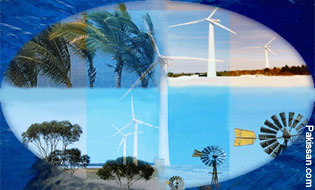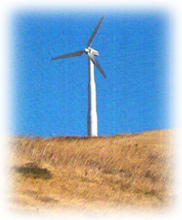|
Electricity from wind
Introduction:
Wind energy is the world’s fastest growing energy source and
is one of the few alternative energy forms with the scale
potential to reach grid penetration amounts of +30% of
electrical supply.
Present World Power Production:
World-wide installed wind generated electric power capacity is
now well close to 25,000 MW (yes! twentyfive thousand
Mega-Watt) and has seen a sustained growth of over 30 % per
year during the last 5 years.
Growth Trend:
The wind power industry has become a US$6 Billion /year
industry. This growth rate is expected to continue or increase
over the next several years with many countries such as the US
and Germany setting aggressive national targets and favorable
fiscal policies.

USA:
USA is ranked number 1 in the world in wind power production.
California, Texas, Montana and several other states are
offering credits of upto 50%.
In Texas, for example, wind power production is highly
encouraged through federal tax credits (production tax
credits), a state-wide requirement for electric utilities to
purchase renewable energy (through renewable portfolio
standards, or RPS), access to the state power grid, net
metering credits for homeowners who produce renewable energy,
and consumer choice of power supplier(through privatization of
power production and marketing), including several wind power
options.
Texas developed 1,600 MW of wind power capacity in 2001.
Progress in Canada:
Recognizing the environmental value of wind generated
electricity, in 2002 Federal Budget, Canada has announced $260
million in production incentives.
The Canadian industry was quick to react and announce its
strategy to be able to produce (or exceed) 10,000 MW of wind
generated power by 2010 .
The National Research Council of Canada was also quick to
respond and the Guidelines for the applications for these
incentives should be ready by now!
For example, by providing 5% of Canada's electricity supply,
Wind Power would generate more than 30 million megawatt-hours
of electricity production per year, creating up to 160,000
jobs, up to 25 million tonnes of greenhouse gas emissions
reductions per year, significant reductions of emissions that
severely impact human health, and up to $20 billion in new
capital investment, taxes and infrastructure predominantly in
rural parts of Canada,".
India's Status on Wind Power Production:
India carried out a similar program at 900 stations throughout
the country and has already recognised this opportunity.
In wind power generation, India ranks fifth in the world. With
an installed capacity of over 1267 MW, India's wind power
potential is estimated at 45 000 MW.
Some 26 project sites have been developed in the high
potential states, in India, under the Demonstration Programme,
resulting in a capacity of 57 MW.
Around 15 domestic companies are now involved in manufacturing
wind power turbines and components, either in joint venture or
through licensed production from international collaborators,
achieving an annual turnover of Rs 1,500 crore.

Opportunity for Pakistan:
This high employment and capital intensive industry represents
a large-scale opportunity for Pakistan
For Pakistan where we have among the world’s best potential
for wind and Solar energy resources, similar production
incentives will attract Billions in Rupees and in Foreign
Currencies of investment, generate thousands of jobs and
implant an extra feather in Pakistan's hat for implementing a
"green-power" program.
Wind is our most likely source of cost-effective renewable
electricity in the short term….Given an appropriate regulatory
framework, wind has the potential to add a new dimension to
our energy sector.
Since the inception of Pakistan we have been seeing Sind urban
communities having "Wind Catch Tunnels" on roofs of their
homes. This indicates that Sind had and perhaps, even now, has
persistant wind blowing. This obviously will be verified by
the department of Meteorology for exact speeds and frequecies.
Indeed, it is wise to make the best use of local wind
resources for generating electricity.
From The winds of MahranValley to the winds of Kaghan Valley
they carry lot of promise of an industry that can last
forever," which is not only environmentally sound, but also
offers regional economic development opportunities that are
indigenous, and perpetual."
We can start with an experimental project, as early as in 3
months, while launching a more formal Feasibility program at
the same time. I am not aware, how much wind data is already
available and how much of it could be analysed to provide
dependable results?
May be we do have wind data from certain areas with enough
confidence that we may start installing Wind turbines in that
area, right away?
the above mentioned program WRAP, finally delineates the
economically feasible areas for Wind Turbine Operation.
Pre-Feasibility:
Wind is one of the largest Renewable Energy Source in the
country, based on Mean Annual Wind Power Density (MAWPD), Wind
Resource Assessment Programme (WRAP) will becarried out in
order to Re-Assess the wind potential, in cooperation with the
Metreology Department. Wind Monitoring and Mapping stations
will be set up in the country which will identify potential
sites.
Also R&D activities be undertaken through Universities,
research institutions, laboratories, technical centres,
already existing in the country. An early action along these
lines may offer leadership role in the design of better and
cheaper wind turbines, which, in turn, may open up the world
market to Pakistani made wind generators
Regional Economic Benefits:
Wind energy is going to contribute fairly large percentage of
Environmentally Sustainable Power, which is almost free from
major recurring bills. Of course, right government policies
and timely support are a vital first step for achieving this,
which would be an excellent step forward towards self
sufficiency in progress of Pakistan.
Wind-generated energy is more secure than other sources of
supply, such as nuclear or fossil fuel plants. Wind Energy is
indigenous available free of cost and offers regional economic
benefits. It is less vulnerable to disruption.

Pakistan's 85% of population is rural, where small Wind energy
Machines should be promoted for private ownership and operated
by each individual farmer/owner.
It is less likely that the production from these small wind
generators would be connected to the main national grid.
If, however, a farmer has his land enroute main WAPDA gridline
and is rich enough to buy larger Wind Power generator, he can
make extra money by selling his excessive production to WAPDA
by injecting his extra production into WAPDA gridline.
Several such machines along the gridline will also improve
overall power supply and cut down blackouts during peak hours
in urban use.
Since the Wind power is free of cost there is no unexpected
price changes resulting from changes in fuel cost.”
The wind energy market is growing by 32% per year worldwide,
creating thousands of jobs. Wind energy is the fastest growing
source of electrical energy and is one of the few technologies
which can be installed almost immediately to meet the current
electrical energy shortage.
Wind energy today represents a strategic opportunity for
Pakistan to develop a cleaner electricity infrastructure at a
time of increasing demand and a worldwide emphasis on
emissions reduction.
If Pakistan did not participate in this infrastructure
revolution and left in a less competitive position than our
next door neighbours, India, who have embraced the wind
technology, in time, or perhaps, I might say, before time, who
rightfully boasts to be Number 5 in the world, Pakistan, once
again, will loose the race in this new industrial revolution.
Electricity shortages and high energy costs are already
driving some of the poor city dwellers steal electricity from
street power lines, (obviously this is no just reason to
steal)
Management Strategy:
Wind energy provides a clean, reliable source of electricity
within a short time frame. Government should focus her
attention to education, training, quality and standards, while
decentralising the management of Wind Power by giving ownship
to the end user.
In that respect a Wind Turbine can be compared to a tractor
which could be purchased under special government program on
easy installments.
A small farmer may want to own a small tractor while a large
CAF (Cooperative Agri Farm) may want to buy large tractor or a
fleet of tractors and Agricultural Machinery and Equipment.
TheGovernment offers equal opportunities to both, yet she
controls the price of their end product, when it comes to
marketing of their surplus.
Additionally, the customer gets the satisfaction, that at the
end of final payment he has no electric bills to pay as well
as no fuel to buy to run his machine. It is free and it is
his.
----------------------------------------------------------
Syed Iqbal Haider
Syed Iqbal Haider is Pakistani Canadian Engineering Consultant
and manages his own consulting company EIC, in Canada.
He is Member of Canadian Wind Energy Association.
Mr Haider has been living in Canada for the last 33 years. He
has taken variety of assignments all around the world,
including industry JV, Technology Development, Reengineering
assignment and feasibility studies in Pakistan.
EIC also represents, US and Canadian Manufacturers of Wind
Power Generating Equipment, in Canada.
|
Pakissan.com;
|